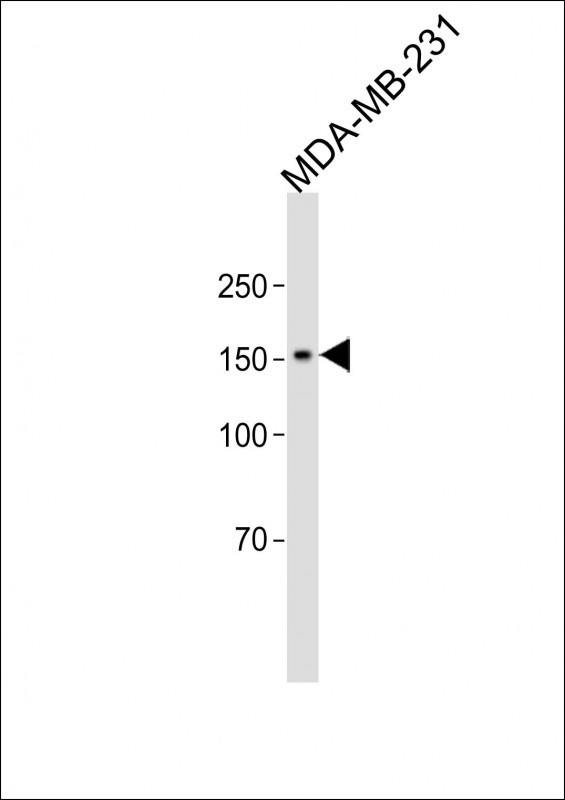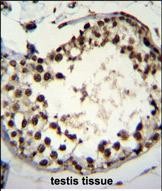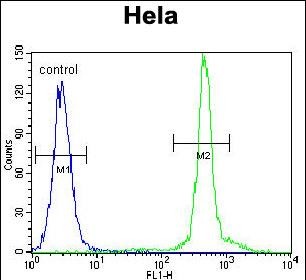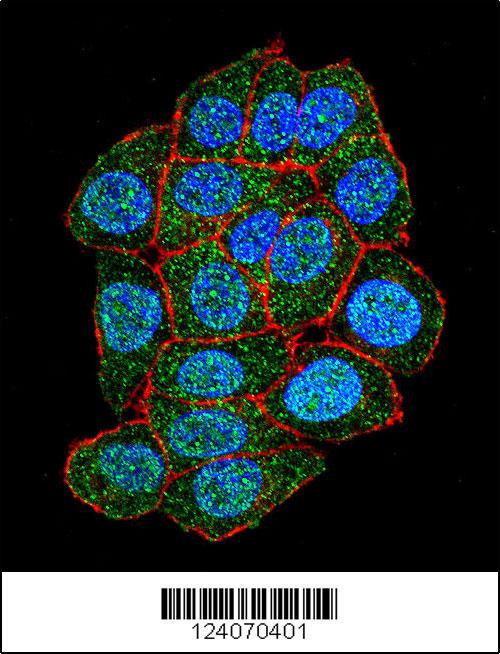ASXL1 Antibody (Center)
Affinity Purified Rabbit Polyclonal Antibody (Pab)
- 产品详情
- 实验流程
- 背景知识
Application
| WB, IHC-P, IF, FC, E |
|---|---|
| Primary Accession | Q8IXJ9 |
| Other Accession | P59598, NP_056153.2 |
| Reactivity | Human, Mouse |
| Host | Rabbit |
| Clonality | Polyclonal |
| Isotype | Rabbit IgG |
| Calculated MW | 165432 Da |
| Antigen Region | 521-549 aa |
| Gene ID | 171023 |
|---|---|
| Other Names | Putative Polycomb group protein ASXL1, Additional sex combs-like protein 1, ASXL1, KIAA0978 |
| Target/Specificity | This ASXL1 antibody is generated from rabbits immunized with a KLH conjugated synthetic peptide between 521-549 amino acids from the Central region of human ASXL1. |
| Dilution | WB~~1:2000 IHC-P~~1:100~500 IF~~1:10~50 FC~~1:10~50 E~~Use at an assay dependent concentration. |
| Format | Purified polyclonal antibody supplied in PBS with 0.05% (V/V) Proclin 300. This antibody is purified through a protein A column, followed by peptide affinity purification. |
| Storage | Maintain refrigerated at 2-8°C for up to 2 weeks. For long term storage store at -20°C in small aliquots to prevent freeze-thaw cycles. |
| Precautions | ASXL1 Antibody (Center) is for research use only and not for use in diagnostic or therapeutic procedures. |
| Name | ASXL1 |
|---|---|
| Synonyms | KIAA0978 |
| Function | Probable Polycomb group (PcG) protein involved in transcriptional regulation mediated by ligand-bound nuclear hormone receptors, such as retinoic acid receptors (RARs) and peroxisome proliferator-activated receptor gamma (PPARG) (PubMed:16606617). Acts as a coactivator of RARA and RXRA through association with NCOA1 (PubMed:16606617). Acts as a corepressor for PPARG and suppresses its adipocyte differentiation-inducing activity (By similarity). Non- catalytic component of the PR-DUB complex, a complex that specifically mediates deubiquitination of histone H2A monoubiquitinated at 'Lys-119' (H2AK119ub1) (PubMed:20436459, PubMed:30664650, PubMed:36180891). Acts as a sensor of N(6)-methyladenine methylation on DNA (6mA): recognizes and binds 6mA DNA, leading to its ubiquitination and degradation by TRIP12, thereby inactivating the PR-DUB complex and regulating Polycomb silencing (PubMed:30982744). The PR-DUB complex is an epigenetic regulator of gene expression and acts as a transcriptional coactivator, affecting genes involved in development, cell communication, signaling, cell proliferation and cell viability (PubMed:30664650, PubMed:36180891). ASXL1, ASXL2 and ASXL3 function redundantly in the PR-DUB complex (By similarity) (PubMed:30664650). The ASXL proteins are essential for chromatin recruitment and transcriptional activation of associated genes (By similarity). ASXL1 and ASXL2 are important for BAP1 protein stability (PubMed:30664650). Together with BAP1, negatively regulates epithelial-mesenchymal transition (EMT) of trophoblast stem cells during placental development by regulating genes involved in epithelial cell integrity, cell adhesion and cytoskeletal organization (PubMed:34170818). |
| Cellular Location | Nucleus. |
| Tissue Location | Widely expressed at low level. Expressed in heart, brain, skeletal muscle, placenta, pancreas, spleen, prostate, small intestine, colon, peripheral blood, leukocytes, bone marrow and fetal liver. Highly expressed in testes. |
For Research Use Only. Not For Use In Diagnostic Procedures.
Provided below are standard protocols that you may find useful for product applications.
BACKGROUND
This gene is similar to the Drosophila additional sex combs gene, which encodes a chromatin-binding protein required for normal determination of segment identity in the developing embryo. The protein is a member of the Polycomb group of proteins, which are necessary for the maintenance of stable repression of homeotic and other loci. The protein is thought to disrupt chromatin in localized areas, enhancing transcription of certain genes while repressing the transcription of other genes. The protein encoded by this gene functions as a ligand-dependent co-activator for retinoic acid receptor in cooperation with nuclear receptor coactivator 1. Mutations in this gene are associated with myelodysplastic syndromes and chronic myelomonocytic leukemia. Alternative splicing results in multiple transcript variants.
REFERENCES
Abdel-Wahab, O., et al. Leukemia 24(9):1656-1657(2010)
Szpurka, H., et al. Leuk. Res. 34(8):969-973(2010)
Sugimoto, Y., et al. Br. J. Haematol. 150(1):83-87(2010)
Boultwood, J., et al. Leukemia 24(6):1139-1145(2010)
Rocquain, J., et al. BMC Cancer 10, 401 (2010) :
终于等到您。ABCEPTA(百远生物)抗体产品。
点击下方“我要评价 ”按钮提交您的反馈信息,您的反馈和评价是我们最宝贵的财富之一,
我们将在1-3个工作日内处理您的反馈信息。
如有疑问,联系:0512-88856768 tech-china@abcepta.com.























 癌症的基本特征包括细胞增殖、血管生成、迁移、凋亡逃避机制和细胞永生等。找到癌症发生过程中这些通路的关键标记物和对应的抗体用于检测至关重要。
癌症的基本特征包括细胞增殖、血管生成、迁移、凋亡逃避机制和细胞永生等。找到癌症发生过程中这些通路的关键标记物和对应的抗体用于检测至关重要。 为您推荐一个泛素化位点预测神器——泛素化分析工具,可以为您的蛋白的泛素化位点作出预测和评分。
为您推荐一个泛素化位点预测神器——泛素化分析工具,可以为您的蛋白的泛素化位点作出预测和评分。 细胞自噬受体图形绘图工具为你的蛋白的细胞受体结合位点作出预测和评分,识别结合到自噬通路中的蛋白是非常重要的,便于让我们理解自噬在正常生理、病理过程中的作用,如发育、细胞分化、神经退化性疾病、压力条件下、感染和癌症。
细胞自噬受体图形绘图工具为你的蛋白的细胞受体结合位点作出预测和评分,识别结合到自噬通路中的蛋白是非常重要的,便于让我们理解自噬在正常生理、病理过程中的作用,如发育、细胞分化、神经退化性疾病、压力条件下、感染和癌症。









